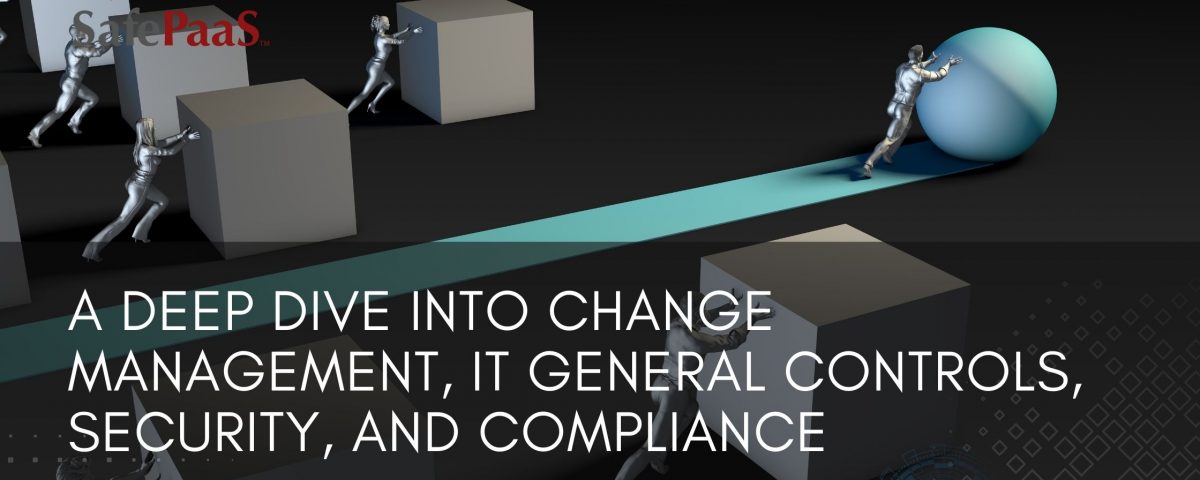Change Management, ITGCs, and Security


A Deep Dive into Change Management,
ITGCs and Security.
Insight from Industry experts Paul Haley, HALEY Consulting and Advisory Services,
and Adil Khan, SafePaaS, CEO.
Change remains a constant in IT, and maneuvering through the change can pose challenges. We understand the complexities involved. Whether you're steering an IT team through a technological shift or embarking on changes within the IT environment, finding timely and reliable information is no easy task. We've compiled a set of key change management concepts and solutions specifically tailored for the ITGC domain to ease your pursuit. Say goodbye to Google searches and uncertainty about data accuracy - we've got you covered.
Change Management - Key Concepts
Change Management as a Protective Mechanism
From an IT perspective, change is inevitable. However, managing change without compromising system integrity or security is an art. Effective change management is not just about implementing alterations within IT systems; it's a protection mechanism ensuring changes are authorized, meticulously tested, and well-documented before implementation. This process is pivotal for IT and becomes a display of governance and compliance when viewed through the lens of audits. Auditors meticulously assess whether changes align with regulatory requirements and that those changes are well-documented.
Foundations of IT Governance: Accountability and Documentation
A clear separation of responsibilities and carefully documented processes lies at the heart of strong IT governance. A responsibility matrix is your guide and should leave no room for ambiguity while enhancing accountability.
Clearly documenting processes, including mapping workflows and setting up checkpoints, creates a clear roadmap for consistent execution. Implementing Policy-Based Access Controls (PBAC) ensures access levels align with individual roles, thereby reducing the risk of unauthorized access.
Additionally, maintaining Segregation of Duties (SoD) involves distributing tasks, which automatically minimizes the risks associated with excessive access and fraud.
Access control and SoD are fundamental practices of effective IT General Controls (ITGCs), serving as a foundation that auditors assess for clarity and effectiveness.
Supporting Processes: Sustaining IT Operations
Supporting processes are the gears that keep IT systems running smoothly. A strong change management process governs alterations, ensuring they are authorized, tested, and documented.
Incident management is critical for swift identification, containment, and resolution of IT incidents, minimizing disruptions and security risks. Proper IT asset management involves detailed tracking, maintenance, and retirement of assets, optimizing utilization, and ensuring compliance with regulations.
Continuous monitoring, analysis, and reporting help proactively address emerging concerns. These processes are indicators of governance and compliance in action from an audit standpoint.
Management of Sensitive Data: Safeguarding Confidentiality
Identifying and managing sensitive data is important for safeguarding confidentiality, integrity, and availability. A complete strategy involves data classification, robust access controls, data encryption, data masking, anonymization, and continuous monitoring.
Auditors examine how well sensitive data is identified, classified, and protected, ensuring controls align with industry standards and regulatory requirements. Compliance with GDPR, HIPAA, or industry-specific standards is crucial for safeguarding sensitive data in line with legal frameworks.
Protecting Critical Infrastructure: Fortification Strategy
Critical infrastructure protection within IT General Controls (ITGCs) involves a multipronged approach, including:
Asset identification,
Vulnerability management,
Stringent access controls,
Network segmentation and
Continuous monitoring ensures the resilience and security of essential IT assets.
Auditors scrutinize the effectiveness of your controls to ensure proper identification, protection, and monitoring of critical assets. Adherence to industry standards and regulatory requirements is pivotal for maintaining a secure IT infrastructure.
Risk Assessment: Enhancing Governance and Control
It's impossible to over-emphasize the importance of a risk assessment as a fundamental step to enhance governance and control mechanisms within your organization's IT landscape.
The process involves several structured steps, including:
Identifying assets
Evaluating potential threats and vulnerabilities
Analyzing risks, assessing existing controls, and
Developing strategies to treat or manage identified risks
Auditors play a crucial role in evaluating the strength and completeness of this risk assessment process. They focus on assessing how well your organization identifies, analyzes, and manages risks, ensuring that your risk management practices align with industry standards and effectively mitigate potential threats within the IT environment.
Automation: Streamlining Governance and Control
Automation is the anchor that streamlines governance and control mechanisms. Automated monitoring tools continuously scan your networks for unusual activity, promptly identifying potential security breaches.
Compliance checks, reporting, and incident response are areas where automation significantly streamlines processes. Automation provides a clear audit trail, ensuring consistent maintenance of logs for detailed records.
10 Ways Access Governance Platforms Simplify and Improve Change Management and ITGC Control
Access governance platforms are instrumental in managing various IT processes, ranging from change management and security controls to audits. These platforms serve as a centralized hub, streamlining and automating the Governance of user access to align with organizational policies, regulatory requirements, and security best practices.
1. Identity and Access Management (IAM): Access governance platforms integrate with your Identity and Access Management systems, facilitating the creation, modification, and deletion of user accounts based on predefined roles and responsibilities. IAM systems manage user identities and their access rights across the organization.
2. Policy-Based Access Controls (PBAC): These platforms enable you to implement and enforce PBAC by defining roles, permissions, and policies. Users are assigned to roles, and access rights are granted or revoked based on job functions, with changes triggering access reviews and certifications.
3. Access Certification and Reviews: Automated access certification campaigns are conducted by access governance platforms, triggering your periodic reviews of user access rights. Managers and data owners receive notifications to review and validate access rights, ensuring ongoing compliance with policies and regulatory requirements.
4. Segregation of Duties (SoD): Continuous monitoring and enforcement of SoD policies are handled by access governance platforms, preventing conflicts of interest. Automated SoD checks are performed during access provisioning and periodically, after that, alert administrators to any violations.
5. Automated Change Management: Integration with change management systems allows access governance platforms to be aware of planned changes in the IT environment. The platform ensures that access rights align with change requests, facilitating a smooth transition during system alterations.
6. Data Classification and Encryption: Integration with data classification tools allows access governance platforms to identify sensitive data. Access controls, encryption, and monitoring mechanisms are enforced based on the sensitivity classification of the data.
7. Continuous Monitoring and Reporting: Access governance platforms provide continuous monitoring through log analysis, generating comprehensive reports on user activities. Automated reporting functionalities offer insights into access patterns, compliance status, and potential risks, aiding in audits.
8. Integration with Industry Standards and Regulations: These platforms support integration with industry standards and regulatory frameworks. Policies and controls are configured to align with specific standards such as NIST, ISO 27001, GDPR, HIPAA, etc., ensuring compliance.
9. Risk Assessment: Access governance platforms contribute to risk assessment through continuous monitoring and analysis of access patterns. Risk scores are assigned based on deviations from established norms, helping organizations prioritize and address high-risk access scenarios.
10. Automation of Audit Trail: Access governance platforms automate the generation and maintenance of detailed audit logs. Auditors can access a clear and complete audit trail, providing evidence of compliance with governance processes.
Access governance platforms are your indispensable ally in IT governance, painlessly orchestrating change management, fortifying your security controls, and ensuring audit readiness.
These platforms elevate your efficiency, mitigate risks, and maintain compliance with regulations by automating processes. Change management is one of the most important aspects of any enterprise. It's not just about making changes; it's about ensuring those changes happen smoothly and securely.
Adapting to change is a cornerstone of organizational resilience in the digital business landscape. Adopting a proactive and strategic approach to your IT change management ensures smooth and secure transitions. It positions your enterprise to thrive amidst evolving challenges and seize emerging opportunities with agility and confidence.
Are you ready to ensure your resilience to change?
Recommended Resources

Resilience and the Crucial Role of ITGCs in Risk Mitigation
ITGCs, are key controls that ensure your organization's IT environment's reliability, integrity, and security. They encompass policies and procedures designed to safeguard data, manage access controls, and mitigate risks, playing a crucial role in maintaining the effectiveness and security of your organization's IT systems.

Everything you need to know about ITGC SOX
If your ITGCs are insufficient it can lead to disclosures to investors if your ITGCs are cited in your financial audit. You also risk losing business if poor ITGCs scare potential customers who are concerned about security risks. Disclosures and poor security will also lead to costly remediation.

Getting Access Certification Right with Governance
Access governance and access management are easily confused. But the scope of access governance extends beyond simply managing access to resources. Access governance defines security processes and policies for the enterprise's management of data.

